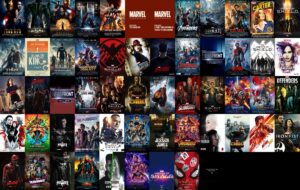Visual Storytelling in the MCU: A Profound Shift in Cinematic Experience

- How Marvel’s New Movie Redefines Superhero Origin Stories
- Marvel’s Cinematic Universe Continues To Defy Expectations At The Box Office
- Marvel’s Cinematic Playground: The Art Of Balancing Humor And Drama
- Why MCU’s Latest Film Is Perfect For Hardcore Fans
- The Most Iconic MCU Movie Weapons
The Marvel Cinematic Universe (MCU) has been continuously pushing the boundaries of visual storytelling, leaving an indelible mark on the world of cinema. Their latest blockbuster is no exception, boasting a striking visual style that sets it apart from its predecessors. In this piece, we’ll delve into the visual narrative of the film and explore the key elements that make it a game-changer.
To start, the movie’s innovative use of color is instantly striking. Gone are the days of muted tones and washed-out hues; the new film is a kaleidoscope of vibrant colors, each one meticulously chosen to evoke a specific mood or atmosphere. The palette is diverse and eclectic, ranging from the warm golden tones of the daytime scenes to the cool, icy blues of the nighttime sequences. This deliberate use of color not only adds to the overall aesthetic but also serves as a narrative device, subtly influencing the audience’s emotional response.
One of the most notable aspects of the film’s visual style is its innovative cinematography. The filmmakers employed a range of techniques, including sweeping pan shots and immersive close-ups, to create a truly immersive experience. The result is a film that draws the viewer in, refusing to let go until the credits roll. Each frame is meticulously crafted, with every element – from lighting to composition – carefully considered to create a captivating visual tapestry.
Another key element in the film’s visual arsenal is its judicious use of CGI. Rather than relying on gratuitous special effects, the filmmakers have wisely chosen to use CGI to enhance the story, rather than overwhelm it. The result is a seamless blend of practical and digital elements, creating a convincingly real world that’s utterly captivating.
Lighting, too, plays a crucial role in setting the film’s tone and atmosphere. The use of high contrast and dramatic shadows creates a sense of tension, heightening the stakes and investing the viewer in the story. Conversely, softer, more muted lighting is employed to convey warmth and vulnerability, making for a richly nuanced visual narrative.
Ultimately, the visual style of the MCU’s latest blockbuster is a testament to the ingenuity and creativity of the filmmakers. By pushing the boundaries of what’s possible on screen, they’ve created a truly immersive experience that leaves the viewer breathless. As we look to the future, it’s clear that the bar has been raised – and we can’t wait to see what’s next.
Visual storytelling has become increasingly integral to modern cinema, and the MCU is at the forefront of this movement. By exploring new techniques and technologies, they’re continually redefining the cinematic landscape, crafting unforgettable experiences that leave a lasting impact on their audience.




